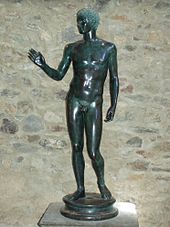Youth from Magdalensberg
The youth from Magdalensberg is a Roman bronze statue from the first century BC. It was found in 1502 on the Carinthian Magdalensberg and is only known today through a cast from the 16th century, which is in the antique collection of the Kunsthistorisches Museum in Vienna (inventory number VI 1).
Until the 20th century, the statue was also known as the "youth from Helenenberg" after the old name for the Magdalensberg.
description
The sculpture made of bronze represents a naked, standing youth roughly life-size (height 1.85 m). The standing leg is the right leg, the free leg is the left one, which only touches the ground with the toes. The left arm hangs freely, the right hand is raised to shoulder height. The head is turned half to the right and follows the gesture of the right hand.
An inscription is carved on the right thigh:
- A [ulus] Poblicius D [ecimi] l [ibertus] Antio [cus]
- Ti [berius] Barbius Q [uinti] P [ublii] l [ibertus] Tiber [inus or -ianus]
It is the dedication of two freedmen who were probably active as traders in the town on the Magdalensberg .
interpretation
No identification as a god image can be derived from either the statue itself or the inscription. Hence there is an abundance of interpretations. These range from athletes to lamp holders ( Lychnophoros ) to various deities. Even a gilded bronze round shield found together with the youth, which is lost today, does not help with the interpretation. The shield bore the inscription
- M. Gallicinus Vindili f [ilius] L [ucius] Barb [ius] L [ucii] l [ibertus] Philoterus pr [ocurator] / Craxsantus / Barbi [i] P [ublii] s [ervus].
The donors of the shield were therefore a free Celt, a freedman of the Upper Italian gens Barbia and a local Celtic slave from the same family. One of the two donors of the young man's statue also belonged to this family.
More recent interpretations see the statue as a cult statue of a Celtic Mars on the sanctuary at the mountaintop, as a Noreia priest, as part of a group of statues dedicated to Noreia, or as a Mercurius statue that stood on the city's forum.
classification
The statue is an eclectic work of the Roman ideal sculpture and was made in the first half of the first century BC. Manufactured. The model was the Greek sculpture of the 5th and 4th centuries BC. It is possibly a copy of a work from the school of Polyklet .
The youth is the only known large antique bronze sculpture from the Eastern Alps and is therefore of national importance.
Provenance

The statue was found in 1502 by a farmer plowing on a terrace south of the summit. Soon afterwards it came into the possession of the bishop of Gurk and humanist Matthäus Lang von Wellenburg . He took them to Salzburg in 1519 when he became Archbishop of Salzburg. Until the 1980s, it was assumed that the statue came from Salzburg to Vienna in 1806. In 1986, however, investigations into the casting technique and scientific analyzes of the metal led to the result that the Vienna statue is a cast from the mid-16th century.
The whereabouts of the original cannot be clarified with certainty. As the minutes of the Salzburg cathedral chapter show, it came into the possession of King Ferdinand I in 1551 after a cast had been made, which initially remained in Salzburg and then came to Vienna in 1806. The original was taken to Spain, where it can be found in the royal gardens of Aranjuez Castle in 1662 and 1786 . However, the original of the statue has been lost since the beginning of the 19th century.
Two images of the original are known. One comes from the inscription Inscriptiones sacrosanctae vetustatis by Petrus Apianus and Bartholomaeus Amantius from 1534, the other is a fresco by Hans Bocksberger the Elder. Ä. in the chapel aisle of the city residence of Landshut from 1542.
literature
- Kurt Gschwantler : The young man from Magdalensberg - a research project of the antiquities collection of the Kunsthistorisches Museum in Vienna . In: Greek and Roman statuettes and large bronzes. Files from the 9th session on ancient bronzes . Vienna 1988, pp. 16-27
- Kurt Gschwantler: The youth from Magdalensberg in Aranjuez. The search for the missing original . In: Yearbook of the Art History Collections in Vienna 89/90 (1993/1994), pp. 311–339
- Gernot Piccottini , Hermann Vetters , with additions by Heimo Dolenz: Guide through the excavations on the Magdalensberg . Verlag des Landesmuseum für Kärnten, Klagenfurt 2003, pp. 7ff, 27ff. ISBN 3-900575-24-X
Individual evidence
- ↑ Werner Fantur: Carinthia in the mosaic of the earth . Verlag Carinthia, Klagenfurt 1974, p. 47–52, chapter “Der Jüngling vom Helenenberg”.
- ^ Gernot Piccottini: The best sculptures of the Austria Romana . In: Wolbert Ebner (Red.): Das ist Kärnten , 5th edition, Klagenfurt 2003, pp. 18-19. ISBN 3-85391-214-1
- ↑ a b CIL 3, 4815 .
- ↑ Otto H. Urban: The long way to history. The prehistory of Austria. (= Austrian history up to 15th BC). Ueberreuter Verlag, Vienna 2003, p. 364, ISBN 3-8000-3969-9

